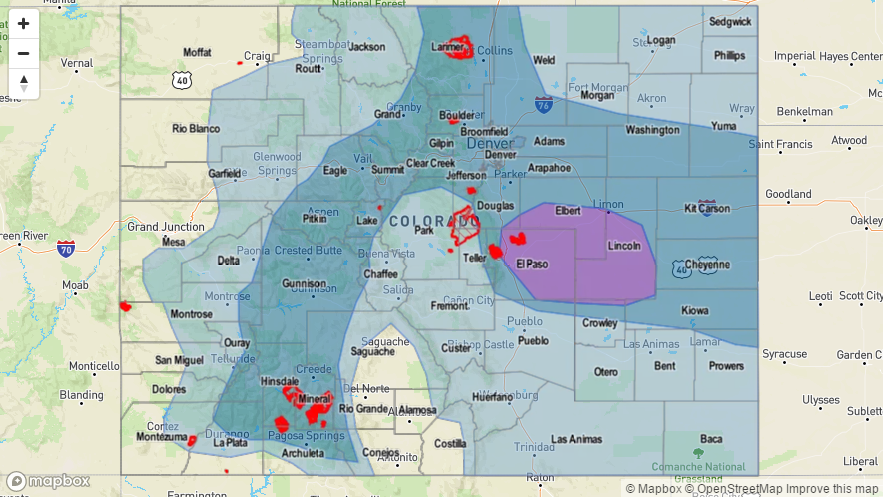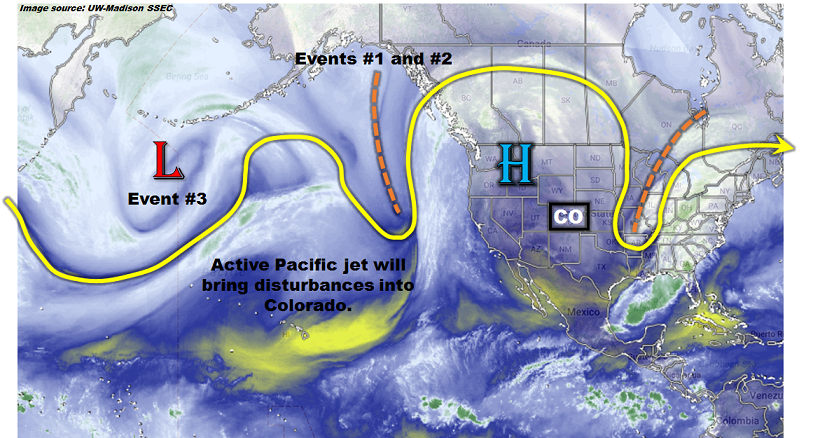Issue Date: May 4th, 2017
Issue Time: 2:10PM MDT
Valid Dates: May 5th – May 19th
This afternoon’s North Pacific water vapor image, below, shows a generally active atmospheric pattern. A strong and elongated jet stream is stretched from east of Japan nearly all the way to North America’s west coast. Within this jet stream are several embedded disturbances, marked as Event 1/2 and Event 3. These will provide the mechanisms for disturbed weather across Colorado over the next 15 days. One additional important feature to note is a sprawling high pressure across the western United States. This feature will be hard to displace over the next two weeks and will provide a quick rebound to warm/hot temperatures after the passage of precipitation events.
The water vapor image acts as a good measure of current conditions. To investigate how this pattern will evolve, we turn to atmospheric weather models for guidance. One guidance tool that we like to use is the Climate Prediction Center’s analog method that essentially finds historical snapshots of conditions that resemble the current model predictions. The image below shows composite anomalies of 500-mb heights, 925-mb air temperature and 925-mb moisture content (specific humidity) centered 8 days from now. The 500-mb anomalies show rather weak features around Colorado with a much more pronounced signal coming in the form of a strong ridge across most of Canada. In fact, models suggest that this ridge will attempt to bulge into the Central Plains surrounded by two low-pressure anomalies in the far western US as well as the eastern US. Both of these disturbances are too far to have direct impact on our weather. Nonetheless, we do expect at least one significant disturbance to penetrate the ridge and provide a multi-day period of inclement weather (Event 1 and 2). After this disturbance passes Colorado, a moderate strength ridge will re-establish itself providing several days of average to above average temperatures. Thereafter, there are indications that the western US low pressure anomaly will progress far enough east to affect Colorado with precipitation chances by late in the forecast period.
Event #1: Saturday (5/6) and Sunday (5/7)
No Apparent Flood Threat
An initial disturbance associated with the large-scale trough off the US west coast will affect mainly the higher elevations on Saturday and Sunday. With little atmospheric instability, we expect light to moderate rain and snow showers across mainly higher elevations of the state. Precipitation amounts up to 0.4 inches will be possible over this two-day period. Isolated thunderstorms cannot be ruled out east of the Continental Divide. However, rain rates will stay below flood threat levels (0.5 inch per hour or less). With precipitation expected to remain below 0.5 inches, a precipitation map is not shown.
Event #2: Tuesday (5/9) through Thursday (5/11)
Elevated Flood Threat as a developing cut-off low moves across Colorado; severe weather possible in southeast Colorado
Guidance tools are in reasonably good agreement that the disturbance responsible for Event #1 will cut-off from the main jet stream, slowing its progression. However, it will continue to slowly move towards Colorado so that by Tuesday, it will begin to affect the southern portion of the state with precipitation. Enough moisture return suggests that there will be instability especially in the southern and eastern parts of the state. Thus, several rounds of showers and thunderstorms are anticipated, with maximum 1-hour rain rates up to 1.0 inch and 24-hour rainfall up to 1.5 inches in the higher elevations. As the disturbance continues to move northeastward, on Wednesday, we expect additional activity for the central and northeastern parts of the state. However, at this point, the amount of instability is in question. It appears the far eastern parts of the state will have the highest risk of flash flooding, while steadier, lighter precipitation affects most everyone else. There is disagreement is how fast this disturbance will move and it is possible that cool weather and light to moderate rain/snow showers remain through Thursday. However, the flood threat will be over by Thursday. See below for total precipitation expected with this event.
 : Tuesday (5/16) through Thursday (5/18)
: Tuesday (5/16) through Thursday (5/18)
No Apparent Flood threat as amount of instability is uncertain
The persistent low-pressure anomaly forecast for the US west coast will move into the Great Basin and possibly affect Colorado during this time period. The amount of moisture return from the Gulf of Mexico will dictate the flood threat with this event. At this time, it does not appear like instability will be high enough for widespread heavy rainfall. Instead, light to moderate precipitation is expected, which would be good news for summer water supply. At this time, precipitation totals are expected to remain below 0.5 inches, and thus, no precipitation map is shown.


